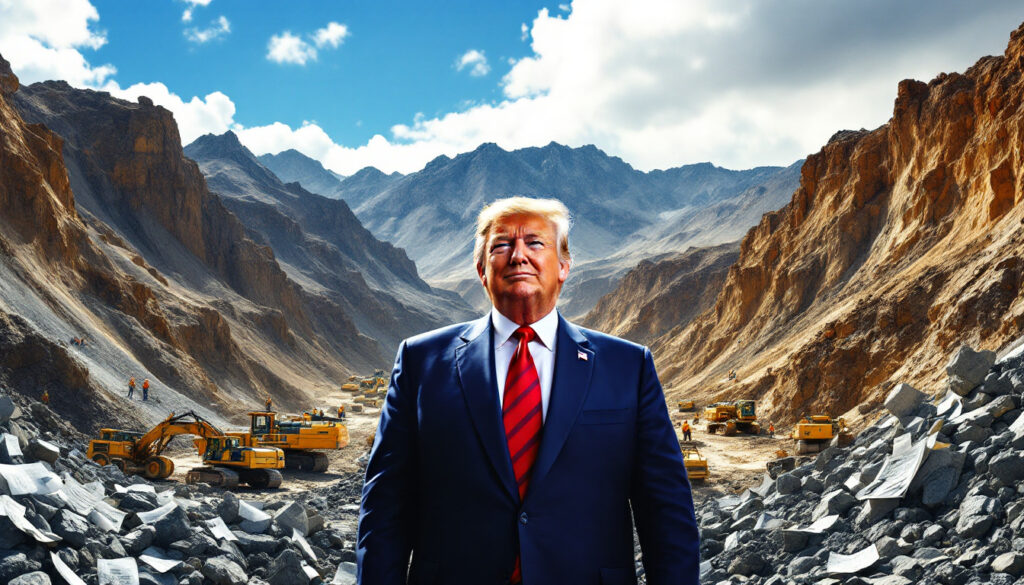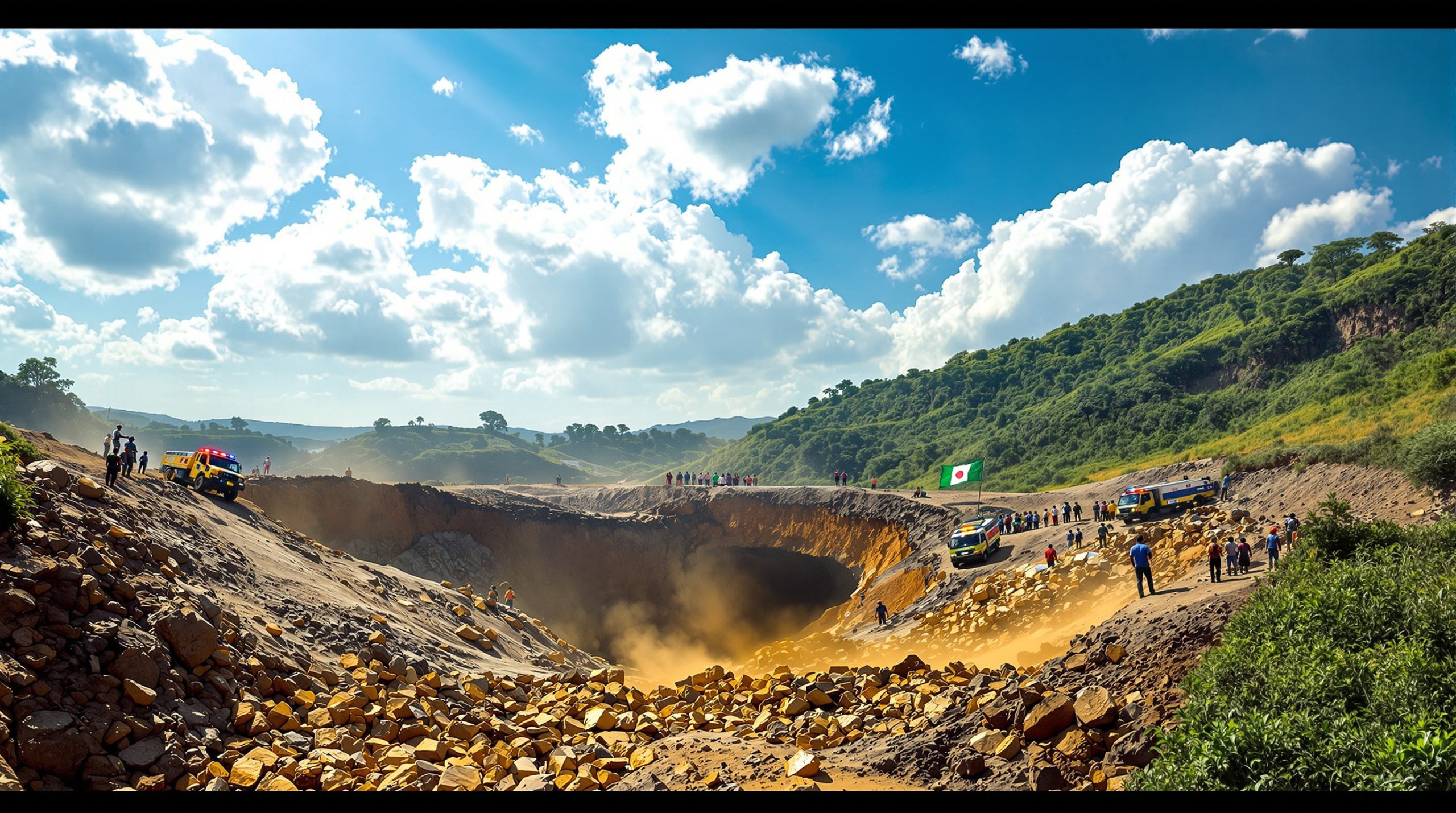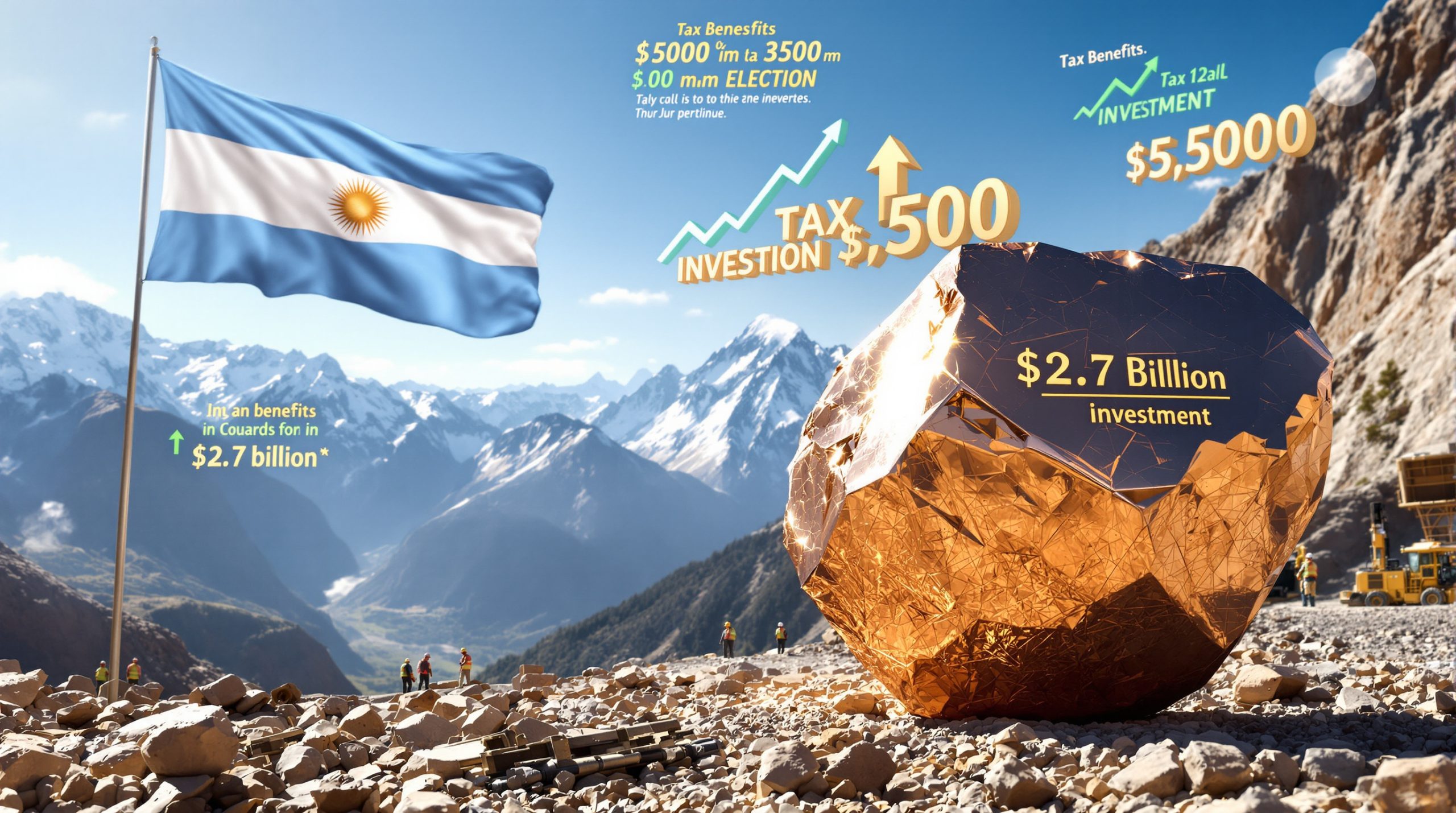What Is Trump's Mineral Production Executive Order?
Key Components of the Executive Order
The mineral production executive order, signed by President Trump in March 2025, represents a pivotal shift in America's approach to resource development. This executive action aims to normalize and significantly reduce permitting costs for mining companies operating within U.S. borders. At its core, the order is designed to dramatically shorten the timeline for obtaining mining permits – transforming what has historically been a 5-10+ year process into a more streamlined procedure.
The order specifically targets the acceleration of domestic mineral production, with particular emphasis on critical minerals deemed essential for economic prosperity and national security. These include rare earth elements, copper, lithium, and antimony, which are vital components in defense applications, renewable energy technologies, and electronic devices.
Historical Context and Significance
This executive order doesn't emerge from a policy vacuum. It follows previous initiatives like the approval of the Amler Access Road, which opened access to significant mineral deposits in Alaska. However, the 2025 order represents a far more comprehensive and aggressive shift in U.S. resource policy than previous measures.
For decades, mining companies have struggled with extraordinarily lengthy permitting timelines in the United States. Projects like the Rosemont copper development in Arizona languished for over 15 years without receiving final permits, despite billions in potential investment. This executive order directly addresses these longstanding issues.
Perhaps most significantly, the order creates what industry experts describe as a "3.5-year window of opportunity" until the next administration potentially takes office. This relatively short timeframe has created urgency among mining companies to advance projects through the permitting process while the favorable regulatory environment persists.
How Does Political Risk Impact Mining Investments?
The Immovable Nature of Resources
Unlike many industries where operations can relocate to more favorable jurisdictions, mining investments are permanently tied to specific geographic locations. As industry veterans often note, "You can't move the rocks" – mineral resources must be extracted where they naturally occur.
This immovable reality creates a unique vulnerability for mining investments. Project economics become inextricably linked to jurisdictional treatment, including permitting processes, taxation regimes, and overall political stability. A world-class deposit can become economically unviable solely due to unfavorable jurisdictional factors.
Local community acceptance represents another critical factor in this equation. Projects facing significant opposition from surrounding communities often encounter permitting delays, legal challenges, and operational disruptions. Even with federal support through Trump's policies reshaping global commodity markets, local dynamics remain crucial for project viability.
Rule of Law Considerations
When evaluating mining jurisdictions, investors increasingly employ a binary assessment: does the jurisdiction have reasonable rule of law, or doesn't it? This straightforward approach helps filter out high-risk opportunities where capital investments might be jeopardized by unpredictable governance.
Recent examples of deteriorating rule of law include Mali, Panama, and Bolivia, where foreign mining companies have faced nationalization of assets, unexpected tax increases, or inability to enforce contracts. The seizure of First Quantum's $10 billion Cobre Panama mine in late 2023 exemplifies how even seemingly stable jurisdictions can rapidly change course.
Foreign companies operating in jurisdictions with compromised rule of law often lack effective recourse when regulations shift unexpectedly. International arbitration processes exist but frequently prove time-consuming and may not result in meaningful compensation. This reality underscores why investors increasingly prioritize jurisdictions with demonstrated stability and predictability in mining regulations.
Permitting Timeline Variations
The stark contrast in permitting timelines across different jurisdictions creates significant competitive advantages for certain countries in attracting mining investment:
Western Australia, widely regarded as the gold standard among tier-one jurisdictions, typically processes mining permits in just 1-2 years. This efficiency, combined with strong rule of law, has helped Western Australia attract significant mining investment despite its remote location.
Canada averages 4-5 years for mining permits, significantly longer than Australia but still considered reasonable within the global context. The country's strong rule of law and established mining culture help offset concerns about these longer timelines.
The United States, prior to Trump's mineral production executive order, had among the longest permitting processes in the developed world, frequently taking 5-10+ years. The Rosemont copper project in Arizona exemplifies this challenge, having spent over 15 years in permitting without reaching production.
Which Mining Jurisdictions Are Most Favorable?
Tier-One Jurisdictions
Western Australia continues to maintain its position as the gold standard for mining investment, offering a compelling combination of reasonable permitting timelines (typically 1-2 years), strong rule of law, and a supportive mining culture. The jurisdiction's efficiency in moving projects from discovery to production has created a competitive advantage in attracting exploration capital.
Canada holds strong appeal despite longer permitting processes (4-5 years on average), thanks to its exceptional geological potential, strong rule of law, and centuries of mining heritage. Different provinces offer varying levels of efficiency, with Quebec and Ontario generally viewed more favorably than British Columbia for permit processing.
The United States, historically handicapped by lengthy permitting timelines, is now experiencing a renaissance of interest following Trump's executive order. While the full impact remains to be seen, early indicators suggest meaningful acceleration in permit processing, particularly for projects aligned with national security interests.
Certain parts of Latin America maintain tier-one status despite regional challenges. Chile, despite recent political uncertainty, continues to attract significant investment in copper projects. Peru's world-class mineral endowment similarly helps offset periodic political turbulence.
Emerging Favorable Jurisdictions
Guyana has emerged as a mining investment destination transformed by recent oil discoveries. The government's newly structured mining code and proactive support for resource development have attracted companies like G Mining Ventures, which recently constructed a new gold mine in the country.
Brazil shows increasing promise with a more expedient permitting process than in previous decades. Bravo Mining's rapid advancement of its Luanga PGM project exemplifies this improvement, with the company achieving significant milestones in a compressed timeframe compared to historical norms.
Argentina under President Milei has implemented pro-business reforms that have reinvigorated interest in the country's substantial mineral resources. These changes include reduced export taxes and greater regulatory certainty, addressing previous concerns about investment security.
Morocco represents one of the most rapid transformations into a mining-friendly jurisdiction in recent years. Companies like AYA Gold & Silver have experienced remarkable cooperation from authorities, enabling them to expand operations and resource estimates significantly faster than would be possible in many Western jurisdictions.
High-Risk Jurisdictions
West African nations including Mali and Burkina Faso have experienced deteriorating rule of law, with military coups and security challenges complicating mining operations. Even established producers face increasing uncertainty about long-term investment security in these regions.
Mexico's mining environment has become increasingly uncertain under recent administrations, with regulatory changes and resource nationalism rhetoric creating concerns about future investment conditions. Major companies have delayed expansion decisions due to this uncertainty.
Panama's nationalization of First Quantum's Cobre Panama mine in late 2023 sent shockwaves through the mining investment community. The $10 billion project's seizure demonstrated how even massive investments can be vulnerable to political shifts, marking Panama as a high-risk jurisdiction for the foreseeable future.
Bolivia's history of asset nationalization continues to limit its ability to attract significant foreign mining investment despite substantial mineral potential. The country's political approach to resource development has resulted in below-optimal development of its mineral wealth.
How Do Mining Laws Change Over Time?
Political Cycles and Mining Regulation
Mining laws frequently become political tools during election cycles, creating periodic uncertainty for investors. This pattern is particularly pronounced in Latin American countries, where resource nationalism often features prominently in campaign rhetoric.
Chile provides an instructive example, with mining regulation becoming a central issue in recent elections. The country's proposed constitutional changes created significant uncertainty for copper producers before ultimately being rejected by voters. This cycle of proposed changes followed by moderation has become a predictable pattern in many mining jurisdictions.
A jurisdiction's ability to maintain stable mining laws through multiple election cycles offers one of the strongest indicators of investment security. Australia's consistent approach to mining regulation across different administrations demonstrates this stability, while other regions experience more pronounced regulatory swings with changing governments.
The recent experience in Panama with First Quantum's Cobre Panama mine serves as a sobering reminder that even seemingly "safe" jurisdictions can undergo unexpected changes. The Cobre Panama dispute implications for global copper supply occurred in a country previously considered to have reasonable rule of law and investment protection.
Positive Regulatory Transformations
Several jurisdictions have undergone positive transformations in their approach to mining regulation. Ecuador's opening to mining investment created an exploration boom that led to significant value creation, with projects like Solaris Resources' Warintza and Lundin Gold's Fruta del Norte advancing from discovery to development.
Colombia established a special legal framework for significant projects that provides enhanced regulatory certainty. This approach recognizes the unique requirements of large-scale mining investments and has helped attract international capital to the country's mining sector.
Suriname has created favorable conditions for exploration that led to significant discoveries, including the world-class Rosebel gold deposit. The country's willingness to work constructively with mining companies has enabled the development of projects that might otherwise remain unexplored.
The current U.S. transformation under Trump's administration represents one of the most significant positive shifts in a major mining jurisdiction in recent years. The executive order's focus on expediting permits addresses a longstanding competitive disadvantage in America's ability to attract mining investment.
Timing Considerations for Projects
Exploration projects, which typically require minimal permitting, can often progress through unfavorable administrative periods. Companies frequently adopt strategies to advance technical understanding during challenging regulatory times, positioning projects for rapid advancement when conditions improve.
Permitted projects generally receive grandfathered protection from regulatory changes, creating significant value for companies that secure approvals before potential shifts in government. This reality creates urgency for advancing projects through permitting while favorable administrations remain in power.
While governments rarely revoke existing permits, the Cobre Panama case serves as a notable exception that has heightened attention to jurisdiction risk. This unprecedented action involved the cancellation of an operating permit for a $10 billion project, resulting in substantial financial losses for investors.
The strategic 3.5-year window created by Trump's executive order has accelerated timelines for many U.S. projects. Companies are prioritizing permit applications to leverage this period of regulatory favorability before potential changes in administration could alter the landscape.
What Companies Are Responding to the U.S. Regulatory Shift?
Companies Pivoting to U.S. Operations
Mako Mining represents one of the clearest examples of companies pivoting toward U.S. opportunities, having purchased the Moss Mine out of bankruptcy in Arizona. This acquisition allows the company to leverage existing permits and infrastructure, accelerating their timeline to potential production.
Monero Alamos has acquired U.S. assets after previously focusing on Mexico, signaling a strategic shift in response to both improving U.S. conditions and deteriorating certainty in Mexico. The company cited Trump's mineral production executive order as a factor in their decision to diversify jurisdictional exposure.
Revival Gold released its first technical study on a new U.S. project, timing the advancement to coincide with improving regulatory conditions. The company has accelerated permitting activities to take advantage of the current administration's more streamlined approach.
West Point Gold has positioned itself specifically for what they describe as a "U.S. mining renaissance," focusing exclusively on domestic projects. The company's strategic focus highlights how some junior miners are building entire business models around the changing U.S. regulatory environment.
Projects Likely to Benefit from Expedited Permitting
Trilogy/South32's VMS project in Alaska stands to benefit significantly from expedited permitting, particularly following the approval of the Amler Access Road. This infrastructure development dramatically improves the project's economics and creates a pathway to production that was previously uncertain.
Perpetua Resources' Stibnite project in Idaho, which would produce antimony (a critical mineral for defense applications) alongside gold, represents a national security priority that aligns perfectly with the executive order's focus. The project's permitting timeline has already shown signs of acceleration.
The Spring Valley project, on which U.S. GoldFields holds a royalty, could see significant value creation through faster permitting. The project's advanced stage means it could move quickly toward production decisions if permitting timelines shorten as anticipated.
Anglo Gold's Nevada discovery, described by company executives as the most significant by a major mining company in 20 years, now has a clearer pathway to development under the new regulatory framework. This world-class discovery highlights how America's mineral potential has been constrained more by regulatory factors than geological limitations.
Market Reactions to Regulatory Changes
Trilogy and South32 stocks moved immediately following Trump's election, demonstrating how market participants quickly recognized the implications for specific projects. The Amler Access Road approval served as an early indicator of the administration's approach to resource development.
Northern Dynasty's Pebble project has seen speculative movement based on potential regulatory improvements, though this controversial project faces additional hurdles beyond standard permitting requirements. The project's long history of challenges illustrates the complex interplay between federal, state, and local factors in U.S. mining projects.
Many U.S. mining stocks haven't fully priced in the potential benefits of regulatory improvements, creating potential opportunities for investors who understand the implications of shortened permitting timelines. Market participants continue to apply substantial "permitting discounts" to U.S. projects based on historical experience.
Companies with permits nearing the approval stage are positioned for the greatest near-term benefit from the executive order. Projects already in advanced stages of the permitting process can potentially reach approval decisions within the current administration's term, maximizing the value creation opportunity.
How Should Investors Approach Jurisdictional Risk?
Management Experience in Jurisdiction
Local expertise has proven critical for successfully navigating complex permitting processes. Companies led by executives with specific experience in the jurisdiction of interest typically achieve better outcomes and encounter fewer unexpected delays.
In-house permitting expertise generally delivers superior results compared to exclusively relying on hired consultants. Companies that maintain dedicated permitting teams with jurisdiction-specific knowledge can adapt more quickly to changing requirements and build stronger relationships with regulatory authorities.
Understanding local stakeholder dynamics represents an essential competency that goes beyond formal permitting requirements. Companies that effectively engage with communities, indigenous groups, and other stakeholders typically encounter fewer obstacles during development.
A track record of successfully developing projects in similar jurisdictions provides one of the strongest indicators of a management team's ability to navigate future challenges. Investors increasingly scrutinize executives' specific jurisdictional experience rather than generic mining credentials.
Project Stage Considerations
Exploration projects typically face minimal exposure to current regulatory environments, as they require limited permitting and can advance technical understanding regardless of broader political conditions. This reality allows exploration companies to work effectively even in challenging jurisdictions.
Development-stage projects show the highest sensitivity to permitting changes, as they typically require multiple major authorizations before construction can begin. These projects often experience the most significant valuation impacts from regulatory shifts like Trump's executive order.
Operating mines generally enjoy substantial protection from regulatory shifts, as governments rarely apply new requirements retroactively to functioning operations. This protection creates a valuable "jurisdictional moat" for producing companies compared to those still seeking permits.
Projects nearing permit applications have the greatest near-term opportunity under Trump's executive order. Companies with submissions planned within the next 12-24 months can potentially achieve approvals within the current administration, maximizing value creation.
Strategic Investment Approach
Diversification across multiple jurisdictions remains a fundamental risk management strategy for mining investors. Even within a portfolio focused on tier-one jurisdictions, spreading investments across different countries and regions helps mitigate the impact of unexpected regulatory changes.
Tier-one jurisdictions should form the core of most mining investment portfolios, providing a foundation of stability and predictability. Western Australia, Canada, and the improving United States environment offer compelling combinations of geological potential and rule of law.
Emerging favorable jurisdictions present growth opportunities for investors willing to accept moderate jurisdiction risk. Countries like Brazil, Guyana, and Morocco offer potentially higher returns to compensate for incrementally higher risk profiles compared to tier-one jurisdictions.
Monitoring political cycles in key mining countries allows investors to anticipate potential regulatory shifts. Election calendars, changing ministerial appointments, and public discourse on resource nationalism all provide valuable signals for jurisdictional risk assessment.
How Does Resource Nationalism Impact Critical Minerals?
Strategic Minerals Most Affected
Rare earth elements face perhaps the most significant resource nationalism pressure, with current production dominated by China. The U.S. has identified these minerals as critically important for defense applications and clean energy technologies, making them a priority under Trump's executive order.
Copper, essential for the energy transition and traditional infrastructure, has become increasingly subject to resource nationalism pressures. Major producers like Chile and Peru have discussed higher taxation and state participation in projects, while the U.S. aims to increase domestic production.
Platinum group metals, concentrated primarily in South Africa and Russia, present strategic vulnerability for Western nations. The minerals' applications in catalytic converters, fuel cells, and other high-tech applications make them priority targets for domestic development.
Antimony, with strategic defense applications including flame retardants for military vehicles and hardening agents for ammunition, exemplifies how previously overlooked minerals have gained national security importance. Perpetua Resources' Stibnite project in Idaho represents one of the few potential Western sources of this mineral currently dominated by Chinese production.
East vs. West Resource Competition
Western nations have increasingly focused on securing domestic supply chains for critical minerals, recognizing vulnerability to supply disruptions from geopolitical competitors. This shift represents a fundamental change from decades of globalized mineral supply chains optimized primarily for cost efficiency.
Critical minerals have explicitly become national security priorities in the United States, European Union, and allied nations. This designation enables expedited permitting, financial support, and other advantages for projects producing these materials.
Investment capital has begun flowing preferentially to projects in allied or friendly nations, creating a bifurcation in global mining finance. Projects in jurisdictions with strong ties to Western nations can now access capital pools unavailable to operations in countries with uncertain geopolitical alignment.
Premium valuations for projects in secure jurisdictions have emerged as investors recognize the strategic advantage of resources in
Ready to Spot the Next Major Mineral Discovery?
Discovery Alert's proprietary Discovery IQ model delivers instant notifications on significant ASX mineral discoveries, turning complex mining data into actionable investment insights. Understand why major mineral discoveries can lead to substantial market returns by exploring our dedicated discoveries page and begin your 30-day free trial today.




